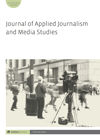
Full text loading...

A journalistic paradigm defines what journalism is, and what journalists should do, in relation to reporting news. Drawing from desk research and in-depth interviews with eighteen data journalists and experts in the United Kingdom, this article discusses the recent development and practices of data journalism in the United Kingdom and their implications for the journalistic paradigm, which involves the substantial use of interviewing. Embracing the opportunities provided by the datafication of society and the British government's open data initiative, UK news organizations have institutionalized and incorporated data journalism into their organizational structure. However, difficulties in practice have emerged, resulting from new, mostly ethically grounded issues surrounding data. Traditional journalistic practices, in particular interviewing and cross-checking, provide a useful, practical guide to solving related problems. The institutionalization of data journalism, as well as traditional journalistic methods and skills coming as a solution, assimilate data journalism into conventional journalistic practices, reinforcing – rather than undermining – the journalistic paradigm.

Article metrics loading...

Full text loading...
References


Publication Date:
https://doi.org/10.1386/ajms_00043_1 Published content will be available immediately after check-out or when it is released in case of a pre-order. Please make sure to be logged in to see all available purchase options.